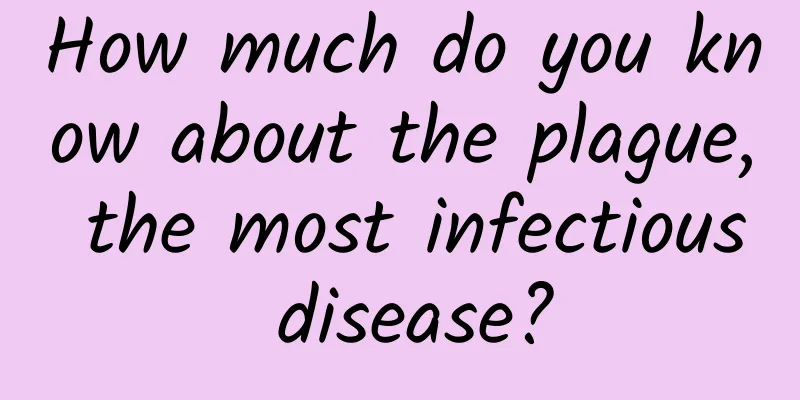How much do you know about the plague, the most infectious disease?

|
Author: Ge Ziruo, attending physician at Beijing Ditan Hospital, Capital Medical University Reviewer: Chen Zhihai, Chief Physician, Beijing Ditan Hospital, Capital Medical University As we all know, plague is the top infectious disease listed in our country and is also known as "disease number one." How much do you know about the plague? 1. How serious is the plague? Plague is a natural zoonosis caused by infection with Yersinia pestis (also known as the pestis bacillus). Clinically, it can manifest as high fever, swollen and painful lymph nodes, bleeding tendency, special inflammatory manifestations of the lungs, and even sepsis, shock, and central nervous system infection. Severe patients may die. In the past, when there were no antibiotics, most plague patients would die from the disease. A major plague epidemic could cause the deaths of millions, tens of millions, or even hundreds of millions of people, but this will no longer happen. We now have very good antibiotics, such as streptomycin, tetracycline antibiotics, aminoglycoside antibiotics, or fluoroquinolone antibiotics. Through antibacterial treatment, the success rate of plague treatment has been greatly improved. Why is plague so serious? The main reason is that it can produce two toxins. One toxin is exotoxin, which we call rat toxin. Rat toxin is particularly pathogenic and antigenic. It can also produce endotoxin, which is lipopolysaccharide toxin, which can cause fever, DIC, hemolysis, toxic shock, and some local or systemic reactions. Yersinia pestis also has many protein antigens, such as capsule F1 antigen, which includes two antigenic components: polysaccharide protein antigen F1 and protein antigen F-1b. It has strong antigenicity and high specificity, and can be used for serological diagnosis. In addition, Yersinia pestis also has a VW antigen. V antigen can stimulate the body to produce protective antibodies. W antigen is a lipoprotein and cannot make the body produce protective antibodies, but the combination of V antigen and W antigen can induce bacteria to produce capsules and protect the existence of bacteria. Due to the presence of these antigens and toxins, plague bacteria can cause serious consequences after infecting the human body. The pestilence bacillus is highly pathogenic, but it has a weak resistance to the outside world. It is sensitive to general heat, dryness and general disinfectants. It will die after 4-5 hours of direct sunlight. It can be inactivated at 55℃ for 15 minutes or 100℃ for 1 minute. The bacteria are highly resistant to cold and can survive for a long time at -30℃. In addition, it can survive for 10-20 minutes in pus and sputum, for 1 month in rat fleas, and for weeks or months on corpses. Figure 1 Original copyright image, no permission to reprint 2. How to treat plague? Plague is a particularly serious disease and is highly contagious, so the requirements for isolation, protection, and treatment are very high. Plague patients should preferably be placed in single rooms, and attention should be paid to the isolation and disinfection of the room and the surrounding environment. Symptomatic supportive treatment is very important in treatment. Pay attention to maintaining water and electrolyte balance, acid-base balance, and adequate energy supply; provide appropriate analgesia for patients with severe pain; perform oxygen therapy for patients with hypoxemia; and all symptomatic supportive treatment methods can be used for patients with severe illnesses such as respiratory failure, shock, encephalitis or meningitis, which is not much different from the treatment of critically ill patients with other diseases. The most important thing in the treatment of plague patients is antibacterial treatment. Early inhibition of the replication and reproduction of plague bacteria and timely control of the disease are crucial to the treatment of plague patients. The first choice of antibiotic for plague treatment is streptomycin. There is no dispute that streptomycin is the most effective antibiotic for plague treatment, but there are different opinions on its dosage. One view is to use it according to the instructions for antibacterial treatment listed in the streptomycin instructions. For example, the first dose is 1g, and the daily dose does not exceed 2g. However, our predecessors believed that such conventional dosages were not effective in the clinical practice of using streptomycin to treat plague, and they proposed a treatment method that far exceeded the normal dosage. For example, for bubonic plague, adults are first injected with 1g as the first dose, and then 0.5-0.75g is injected every 4-6 hours until the body temperature drops. After the body temperature returns to normal, the drug is continued for three days, and the dose is reduced to 1-2g per day, divided into 2-4 injections. For pneumonic plague or plague septicemia, a larger dose is used. The first dose is 2g, and then 1g every 4-6 hours until the body temperature drops. After the symptoms improve, continue to use it for 3-5 days, and the daily dose is reduced to 2g. Figure 2 Original copyright image, no permission to reprint In addition to streptomycin, tetracycline antibiotics, ampicillin, third-generation cephalosporins, etc. can also be used in combination. Fluoroquinolone antibacterial drugs such as ciprofloxacin and levofloxacin can also be used at the same time. Combination therapy is also very important to improve the treatment effect. In addition to the above antibiotics, we also have carbapenem antibiotics that are very effective against Gram-negative bacteria, such as imipenem, meropenem, etc. In theory, these advanced antibiotics may be more effective, but there is insufficient experience in using these drugs to treat plague in clinical practice, and there are not many published articles, so our current antibacterial treatment mainly uses streptomycin combined with one or two other types of antibacterial drugs. |
<<: This infectious disease is related to mosquito bites! What are the symptoms? How to treat it?
>>: Vomiting and diarrhea - how to deal with cholera?
Recommend
Yellow leucorrhea during pregnancy
If the secretions of a pregnant woman are light y...
[Health Science] 3.21 World Down Syndrome Day | Prevent Down Syndrome and Care for Children with Down Syndrome
There is a group of children whose lives have dev...
What are the effects of endocrine disorders on menstruation in women?
If menstrual disorders or amenorrhea are caused b...
When will the 2020 train ticket refund period be extended? How to refund the 2020 Spring Festival Wuhan train ticket?
Due to the epidemic in Wuhan, trains in Wuhan hav...
What does the second degree of cleanliness in secretion inspection mean?
Due to the normal metabolism of the body, women w...
Premonitory discharge
Discharge is a physiological secretion of women c...
What to do if you have hemorrhoid bleeding after childbirth
Postpartum hemorrhoidal bleeding is a problem tha...
What's the matter with the itchiness down there?
In general, female friends must ensure the health...
What are the symptoms of pregnancy if menstruation is not coming?
If a woman has a delayed menstrual period after h...
What to do if you have anemia and dizziness after medical abortion
If anemia and dizziness occur after medical abort...
Why does vaginal tearing occur during childbirth?
Ten months of pregnancy and one day of delivery. ...
How long after pregnancy can I have sex?
IUD insertion is a long-term contraceptive method...
A picture of a woman's vaginal discharge
Nowadays, the influence of women in daily life co...
Can I take maca for gynecological inflammation?
Maca, a natural health product, is very popular a...





![[Fat Bear Science] Are cancer patients prone to malnutrition? These 7 tips can help a lot](/upload/images/67f1e8626ad55.webp)



